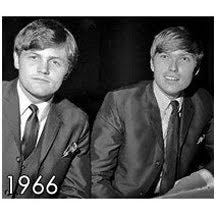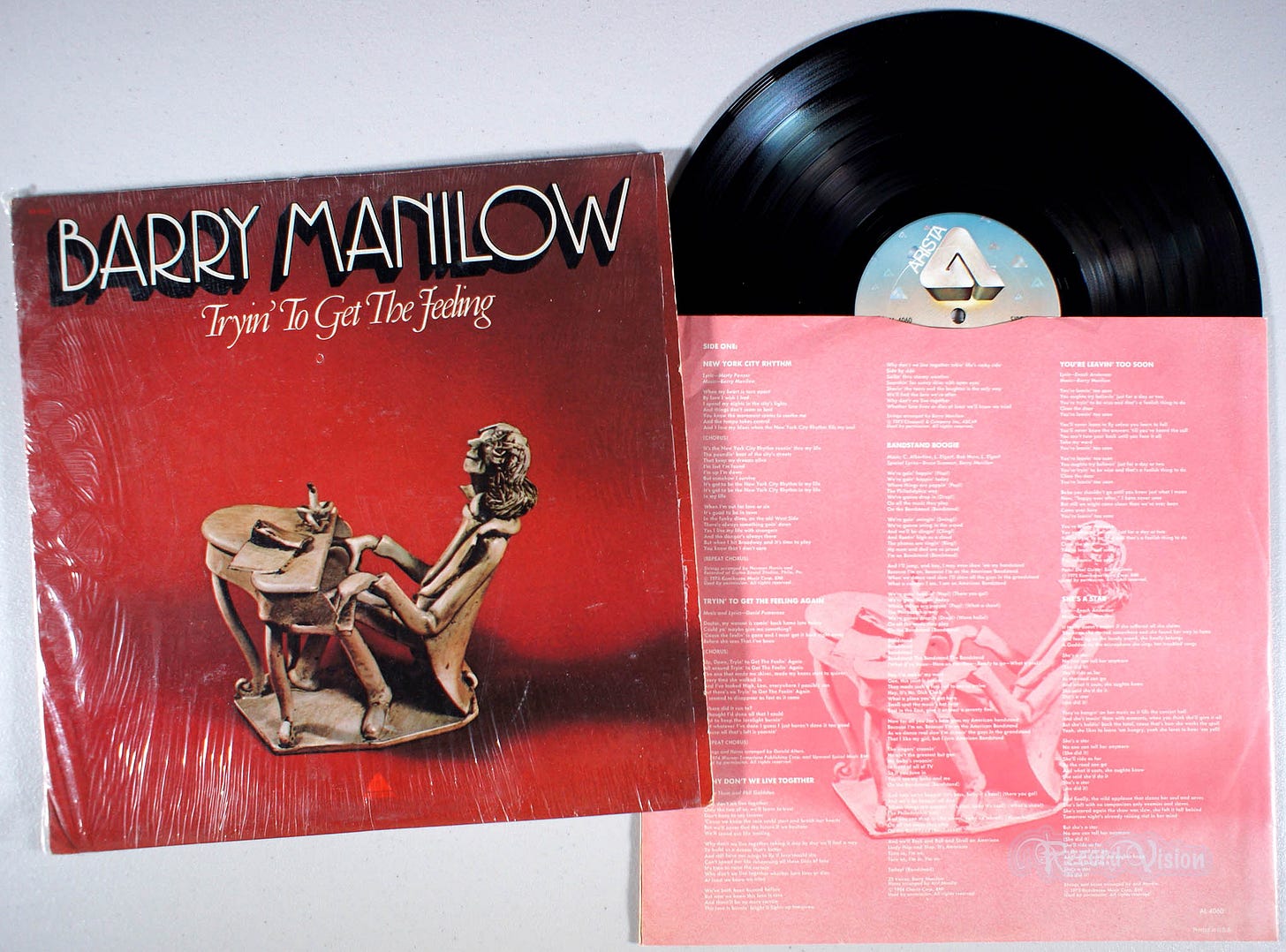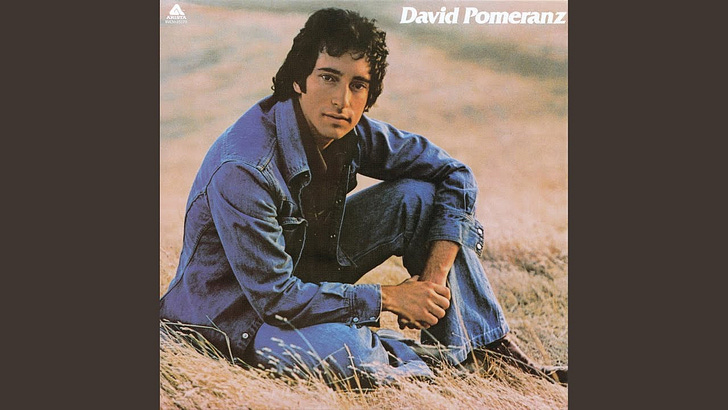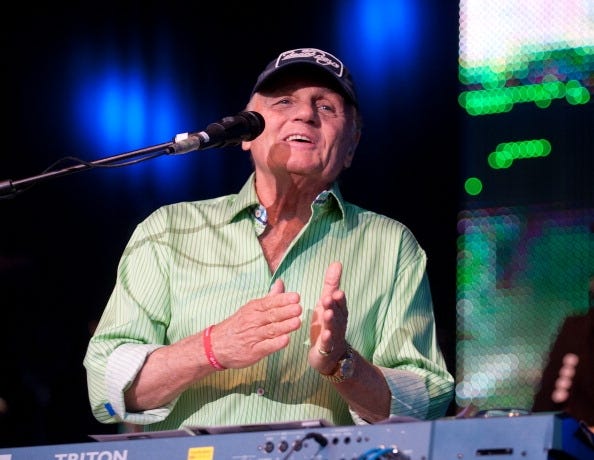🎼They Write the Songs, Pt. 1: Barry Manilow Hits as Recorded by the Original Songwriters
Arranging 101: While he wrote a lot of songs (with trusted colleagues), "I Write the Songs" wasn't one of them. Here are 3 of Barry's biggest hits as first recorded by the original songwriters!
Tale o’ the Tape
Back in the wacky days of the cassette mix-tape craze (late-’80s for me), I made a variety of mix-tapes…songs about the radio, and songs about cars and other things!
Clearly, back in that day, creating mix-tapes wasn’t solely an American hobby. Current London resident,
of Substack’s popular record-celebrating venue, The Vinyl Room, recalls his youth as an habitual taper:“As for mixtapes, my memories as a kid in Argentina taping songs from the radio include the adrenaline of making sure to stop the ‘Rec’ button before the radio commentator started talking!
“And, then in the early 2000s, burning CDs with different tracks I was obsessed with. I remember being obsessed with songs which had the word ‘blues’ in them (‘Kozmic Blues’ by Janis Joplin comes to mind), and having found on the Internet a song by Queen not many people know called, ‘My Melancholy Blues.’
“It was the only song in my mixtapes that my late grandfather (who played organ in church, and piano and accordion at home) showed some interest in. Very funny that I used to include gems like this amidst the sappy, more commercial stuff I was listening to as a kid/young teen!”
Very Fanilow: I Cite the Wrongs
But, from my Buena Park (CA) apartment, I also made a mix-tape of Barry Manilow songs as recorded by their original songwriters…yes, it helped that they had their own recording contracts (and, that I already had their albums)!
Having seen Barry in concert a small handful of times in the late ‘70s, I recalled that he didn’t often mention the original songwriter before or after singing another’s composition.
And, despite his signature melodic declaration, “I Write the Songs,” I discovered, early on, two things: He didn’t write that one, and I couldn’t recall him mentioning Bruce Johnston’s name from the stage, either!
But, after adding (longtime Beach Boy, and purveyor of surf music pre-Beach Boys, with Bruce and Terry, above) Johnston’s debut solo album (1977’s Going Public on Columbia Records) to my collection, I discovered that it was, indeed, Johnston who wrote that song about how music, itself, is the “creator” of all things musical, and not one Barry Alan Pincus from Brooklyn.
It seems, with cassette in hand, that I was on a musical mission in the late ‘80s: To record the original artist’s version of as many Manilow hits as possible, thus honoring the gift of each song’s creator.
That, ultimately, would allow the listener to enjoy and appreciate the transformation of the “demo” into a thing of chart-topping beauty by Barry Manilow, who, among his obvious abundance of many artistic gifts, is certainly a master of song arrangement, as we’ll hear.
The Joy of Sets
I’ve watched, listened to, and followed Barry’s career since reading (in AfterDark mag, Andy Warhol’s Interview, et al) about his early ‘70s days backing a simple cabaret singer named Bette Midler (pre-Atlantic Records and movie-star Bette).
Barry arranged her songs and played piano during her sets (mostly at NYC’s Continental Baths to men dressed in their best evening towels, black tie optional):

Rare footage of Bette and Barry from the Ansonia Hotel’s Continental. Barry, proudly clad in pre-custom-stage-gear (custom clothes will become de rigueur in just a couple years after a hit or two), sits stoically at an upright in aviators and his best Sears off-the-rack Sansabelt slacks and polyester shirt:
Midler, a veritable performing tornado a simple bathhouse couldn’t hope to contain, spent the lion’s share of 1972 recording her debut Atlantic LP, The Divine Miss M: Written by Buzzy Linhart and Mark “Moogy” Klingman, Barry co-produced (with Ahmet Ertegun and Geoffrey Haslam), played piano, sang backing vocals (and, this is what he does best, folks👉) arranged, and arranged the strings and horns. Hey, you gotta have “Friends”:
Just seven months later (July 1973), Bell Records released Barry’s self-titled debut. It took a muddled realignment of Columbia Pictures’ music division to bring Clive Davis into the picture in November 1974, as he re-named the now-eliminated Bell….Arista Records.
Famously, of the dozens of artists on the Bell roster, Clive kept, on the new Arista, only Melissa Manchester, the Bay City Rollers, and “What’s a Barry Manilow?” Barry takes a couple minutes here to remember that initial meeting with Clive:
The Lone Arranger
Not long after, Clive appeared on TV’s The Midnight Special to introduce Barry as “a new star for America.” Barry has gone on to reveal that he had a hard time getting out from behind his comfort-zone of the piano, grabbing a mic and suddenly becoming a “performer,” and all that that word entails.
“I learned from Bette how to perform, how to do a show,” he told The Hollywood Reporter in 2014. “I made a fool of myself trying to copy her, and it was all wrong until I figured out my personality on the stage.”
I’m also going to guess he took vocal or singing lessons, although I’m betting no recorded evidence of that notion exists. Becoming acclimated, at the drop of a hat, to the sudden rigors and wear and tear on the vocal cords had to be something he tended to.
We’re not evaluating Barry’s voice here, or taking a look at any of his compositions. These are songs he chose to record and make his own…in short, we take a look into Manilow’s most prodigious talent: his ability to arrange music.
As New Directions in Music writer,
, recently observed in his recent tribute to the late Burt Bacharach, “often the best pop music is highly planned and structured, each flourish and gesture gently laid into its perfect setting like a jewel.”Listen to each songwriter’s original recording as if you were Manilow hearing a raw demo. What did he hear in each that made him think that the song would end up climbing to the top of the charts, especially with a chord-change here, a chorus-build or a string-swell there, and of course, by adding his signature move, a carefully-placed modulation?
The “Brandy” Re-Branding
Richard Kerr was a notable go-to songwriter for Manilow. He shows up later in Part 2 of our Playlist. In 1971, Kerr co-wrote “Brandy” with Scott English, who recorded it in 1971, followed quickly by New Zealander, Bunny Walters.
Clive insisted Barry change “Brandy”s name to “Mandy,” to avoid confusion with the Elliot Lurie song, “Brandy (You’re a Fine Girl),” a multi-national hit for Looking Glass (above) that Clive worked and pushed for Epic Records during his last couple years heading CBS, in 1972.
In 2013, Scott English told interviewer, Paul Leslie, that “he hated the Manilow version because he took out part of a verse and made it a bridge” but, he later loved it because “it bought him houses.” The song was inspired by his life, he added, “the face in the window” being his father. English died in 2018 at 81.
Barry, here, explains how Clive brought him the Scott English song, and the initial missteps he had in turning a rough rock song into a “career-making” ballad:
Fil from Wings of Pagasus on YouTube dissects “Brandy,” from a pure arranging POV, explaining how Barry effectuated her musical transition from “Brandy” into “Mandy”:
Tryin’ to Get The Feeling That’s Probably Not Right Again
With apologies to David, it was his song that apparently prompted this delicious Ray Stevens tribute/parody, poking a bit of fun not only at Barry’s persistent lyrical kvetching, but accurately and brilliantly aping The Master’s double-tracked vocals, swelling chorus, overwrought orchestrations, and dramatic, climactic drum-work announcing the song’s finish! A modulation? Oh, it’s there!
So, thank you, David Pomeranz! Your “Tryin’ to Get the Feeling Again” probably was the catalyst behind the Dale Gonyea-penned, “I Need Your Help Barry Manilow,” but was certainly the song that squeezed out The Feeling’s Not Right Again as the title for Ray’s 1979 album on Warner Bros. Records, which Stevens produced (and went so far as to hilariously re-create the album cover to Barry’s third LP, Tryin’ to Get the Feeling, shown above)!
Like Richard Kerr, Long Island native, David Pomeranz (who just turned 72), was a multi-hit go-to for Manilow, with 1981’s “The Old Songs” popping up on our “They Write the Songs, Pt. 3” Playlist.
In 1975, David shared roster space with Barry on Clive Davis’s Arista Records on an album he called It’s in Everyone of Us. The album was produced by Vini Poncia, who co-wrote The Ronettes’ “Do I Love You” (produced by Phil Spector) a decade before, a song which was featured prominently on FR&B’s Valentine’s Day “I Love You” Playlist.
David, according to Songfacts, wrote the song during a time of stress in his marriage, referring to its ups and downs. He notes that he rewrote the song several times, and that his version, the Manilow version, and the Carpenters’ version each include different verses:
“The music came first. There’s a line with the title, ‘That up/down, trying to get the feeling again.’ I think it was something that came organically, and I sort of tried to get the feeling again. I didn't understand what the song meant, and I had to sort of work backwards and discover what the lyrics were going to say, but that often happens, where I’ll just have a title, and not know really, fully what the song’s about until I kind of delve into it.
“I wrote it in San Francisco. I remember sitting out on a rooftop writing that. It took a little less than a year, but it was something I just couldn’t get right. The beginning of the song has verses in it which are the initial kind of set-up to the song.
“So the, ‘Doctor, my woman is coming back home late today,’ that thing, I was working on that for several months, the body of the song, and I just couldn’t get that opening verse right. I wrote several versions, one Barry recorded, one the Carpenters recorded, and one I recorded on Arista. And they were all different verses, which is really funny. It was those maybe five lines that I had worked on for four to six months, I just couldn’t get it right…funny.
“It was actually written for the Carpenters,” David remembered. “I had heard that they were looking for a song, and they never recorded it, or so I thought. Then Barry put his record out, and it was as big of a hit as it was, and then cautiously, they released an album of the Carpenters called Interpretations in 1995, and on it was a version of ‘Tryin’ To Get The Feeling’ that Karen had recorded, which was a complete surprise to everybody.”
As with most Carpenters recordings, Richard Carpenter produced and arranged, and also scored a stirring, swirling string arrangement for Karen’s version:
Karen was singing from a “work lead,” reading the lyrics on sheet music for, possibly, the first time. Listen carefully for her flipping a sheet over at about the 1:50 mark as she sight-reads and sings! Richard felt that the vocal was good enough to finish production and release the song, as he did in 1994, almost 20 years after it was recorded. The Carpenters’ version includes the original bridge.
David’s arrangement of his song:
David reveals how Barry found the song: “My publisher at the time, Warner Brothers Music—I had a good friend there who was the president, his name was Ed Silvers. Ed had given my demo to Bette Midler, and Bette was considering recording the song, and Barry at that time worked with Bette, he was her musical director.
“She played it for him at her house, and the story goes that Barry said, ‘If it ever comes to pass that you don’t record that song, I’d like to.’”
Here’s an unreleased alternate take of Barry’s cover (some slight differences in background instruments and chorus, with Ron Dante and Barry, multi-tracking).
Barry opted to use David’s alternate “Doctor, my woman,” opening, instead of “At any moment, she’ll be walking in through that door, but she won’t find me behind it,” plus Barry includes the original bridge on this take, making it somewhat longer.
Manilow, in his 1992 CD box set, The Complete Collection and Then Some, said, “This is a gorgeous song. There's a beautiful bridge that we had to eliminate for the sake of timing. When I sing it in person, I always try to include David’s bridge.”
Pomeranz: “I didn’t know that the bridge was cut until I heard the finished record. Obviously I was thrilled that he was going to record it, [and] I probably squawked at the time. But, his record is a very good Barry Manilow record.
“I got used to it quickly, and I realized that was a really good record he made, with or without the bridge. My bridge is on subsequent versions, so people have heard the whole song. But I like what he did. I think, at the time, I was a little upset by it, because I’d worked so hard on the song.
“Over time...it was flawless. He did a good job, different than a David Pomeranz record. It’s a different kind of a rendition.”
David Pomeranz, YouTube Content Creator, Interviews Barry Manilow, June 2022:
BONUS: David and FRONT ROW & BACKSTAGE’s Stephen Michael Schwartz got together in the late ‘80s to collab on this rare and little-heard song, “Right Foot, Left Foot”! HEAR the RARE SONG DEMO, and discover the story (in Stephen’s own words) of how David and Stephen’s song narrowly missed being the theme song to a popular ABC-TV prime time drama!👇
There’s more!
Travel back to Christmas 2022, and our Holiday Playlist of rarely-heard Christmas songs! You’ll hear the Stephen Michael Schwartz composition, “Merry Christmas (Wherever You Are)” and SEE Barry sing it on an ‘80s TV Christmas Special, here!
Barry Manilow Does a Barry Manilow Parody!
Recorded for his 1976 This One’s For You album (but failing to make the final track listing), and answering the hubbub surrounding his recording of, and questions surrounding whether he wrote “I Write the Songs,” the above showed up as a bonus track on the album’s 2006 re-release. We love it when superstars display a sense of self-deprecating humor, and this one is hilarious!
I Wrote the “I Write the Songs” Song…Right?
Longtime Beach Boys member, Bruce Johnston (above), started brainstorming the lyrics while he was driving on L.A.’s San Diego Freeway [“the 405,” locally, and if you’re stuck on it at rush hour], and rushed home to come up with some verses and a bridge: “I put it all together and found that I'd written a song about where I think music comes from,” he explained in Manilow’s The Complete Collection liner notes.
David Cassidy (about whom a veritable ton has been written on FR&B, starting here) released a successful version of “I Write the Songs” from his 1975 The Higher They Climb RCA album that was a single in England and hit #11 on the UK charts. Arista chief, Clive Davis, hearing Cassidy’s version, had Manilow record it.
Barry’s immediate take? “I had vowed that ‘Mandy’ was going to be the only outside [cover] song I’d ever record [a quaint, even naive, but certainly understandable reaction from one just off the artistic starting blocks], but for [my] very next album, Tryin’ To Get The Feeling, Clive found what he considered to be another smash hit,” Manilow recalled in his 1987 autobiography, Sweet Life: Adventures On The Way To Paradise. “The irony was that its title was ‘I Write The Songs!’”
From the liner notes of his The Complete Collection, Barry was originally reluctant to record the song, telling Clive: “This ‘I Write The Songs’ thing Clive, I really don't want to do it.”
Manilow’s concern? “That listeners would think I was singing about how I write the songs, when it was really about the inspiration of music. Clive understood, but didn't think it would be a problem: ‘Besides,’ he told me, ‘You do write songs!’”
Manilow added that, despite his initial concern about coming off as a gigantic egomaniac, he truly liked the song so much he decided to record it. He added, “Whenever I heard the song in public, I felt the need to run to everyone who was listening and say, ‘You know, I’m really not singing about myself!’”
















I can’t believe Fil from Wings of Pegasus dissected “Mandy”! I have watched many a video breakdown from him and he’s great. And I am slapping myself for not realizing that Mandy wasn’t a Manilow original. I assumed that the real “Mandy” didn’t want the name Mandy Manilow. All along it was a code for the MANdy he was really singing to.
As you well know, as a life-long Manilow fan, I defend his songwriting and arranging to almost-the-death. Though ”Mandy” has some trauma attached as I misguidedly attempted to sing it at karaoke and butchered the song so bad I had to stop being a vegetarian.
The good old days of creating mixtapes! I know we have playlists nowadays, with greater functionality and tons of features we could only dream of back then, but it’s just not the same. Thanks a lot for the mention, Brad. I appreciate it a lot!